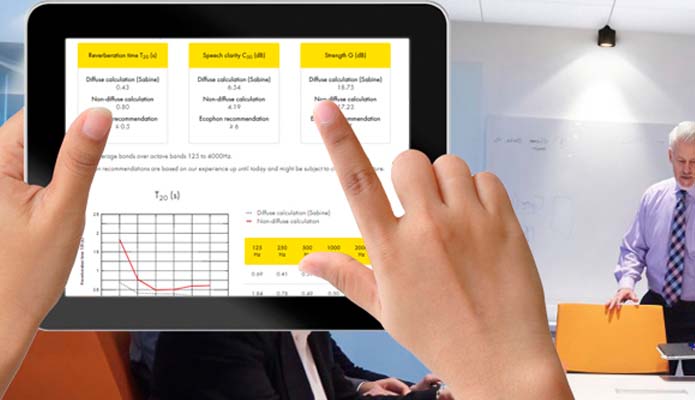
Calculation tools
Recently a new acoustic calculation tool has been published. It is based on Air Flow Resistance (AFR) and calculates several room acoustic descriptors. This article aims to explain why calculations based on the Sabine equation are not always the whole truth.
Background – Sabine and ISO 3382-1/2
A long tradition of research shows that multiple acoustic descriptors are necessary to secure good room acoustics in educational, office and healthcare facilities. Acoustic descriptors such as reverberation time (RT), Clarity (C50), Deutlichkeit/Definition (D50) and Room Gain/Strength (G) support low noise levels, good speech intelligibility and sufficient signal-to-noise ratios, but calculations and measurements of RT alone are still used to evaluate rooms.
RT was developed by W. Sabine in the 1890s and requires a diffuse sound field (reflexes from all surfaces/angles) and still remains the preferred descriptor even though most traditional facilities where speech and communication take place cannot be described as a diffused sound fields since most of the absorption material is often on one surface; the ceiling.
ISO 354 and the practical absorption coefficient αp
When the Sabine formula is utilized to calculate not only RT but also as a ‘tool’ to predict other descriptors, the practical absorption coefficient αp is used. To get the αp the acoustic product has to be tested in a reverberation room according to ISO 354 (fig. 1). A product will always absorb from 0 to 1 and is evaluated in octave bands from 125 to 4000 Hz, but because of diffraction effect we can see results above 1.
The reason for values above 1 is that when we do measurements according to ISO 354 we have a limited test sample area. The size of the area will influence the absorption coefficients (diffraction phenomenon) – especially at the low frequencies.
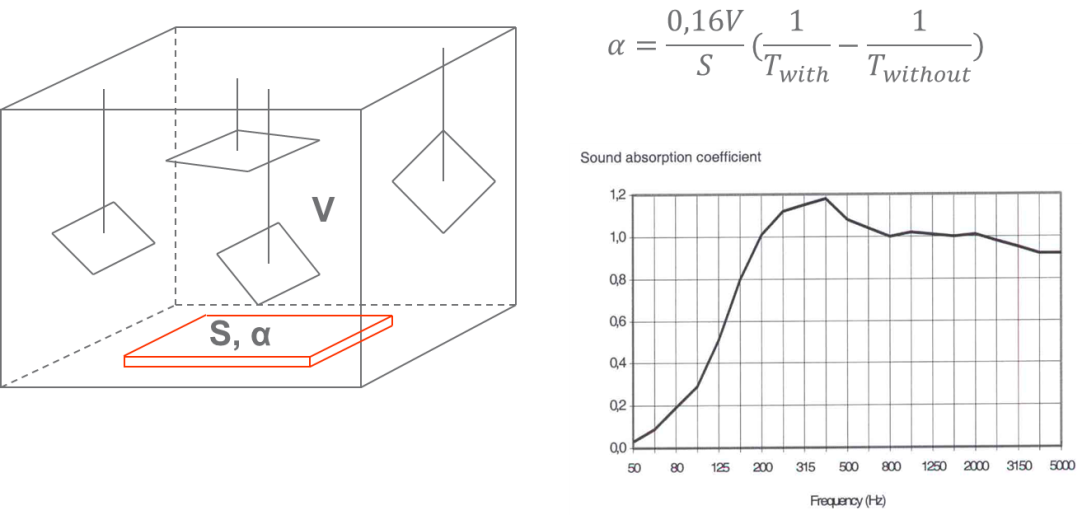
When we test acoustic absorbers according to ISO 354 the labs also play an important role: Differences can be seen from one lab to another and to be really strict the results should only be used to compare products’ performance if they are measured in the same lab at the same occasion. Therefore, this together with large standard deviations in repeatability and reproducibility in general, the αp can be seen as a specific lab product property only – and not as product property in regards to acoustic design in reality.
ISO 11654 and the classification of products
When we compare acoustic absorbers we often do it according to ISO 11654 that in a simple way classifies the products from A to E ( + unclassified). This standard gives us a weighted sound insulation index and is a further simplification based on the αp that is still problematic to use. The αp values are compared to fixed reference curves and based on these the product is classified and we get the αw. (Fig. 2).
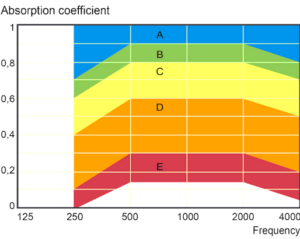
It is really easy to communicate this weighted index and αw to all target groups and it is maybe the easiest way to communicate acoustic performance to laymen, but we need to remember that this index is ‘just’ a simplified ‘version’ based on αp that – because of the method, has some challenges. Besides this a specified overall dept of system (o.d.s) must always be stated for a given absorption class since a change of the o.d.s can change the classification of the product. Besides that this classification can also be used for constructions that contain not only acoustic absorbers (and air in the o.d.s) but also contain e.g. insulation
material above the acoustic absorber. Again this index does not give us the answer to how a product itself will perform in reality but it gives us a simple comparable number based on lab results.
Introducing AFR – air flow resistance* / air flow resistivity**
It is possible to find more accurate real life product specific properties for porous absorbers and it is possible to calculate the acoustic descriptors RT, C50 / D50 and G in a way that is more related to activity based acoustic design in reality. It is possible to calculate absorption coefficients that are more reliable and therefor can be used as input data in models. The answer is AFR for porous products.
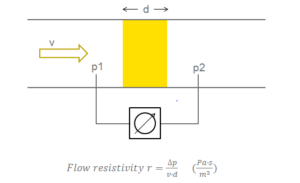
AFR is a pure product specific property and the testing method does not have the same problems as mentioned describing ISO 354 and ISO 11654. Air flow resistivity** is tested according to ISO 9053 and it simply evaluates sound waves’ propagation through the absorber by measuring the difference between p1 and p2 (p=pressure) and divide it by the speed (v) times the thickness of the absorber (d). (NB. Air flow resistance* is only divided by the by the speed (v)).
It is important to state that there is no such thing as a ‘perfect’ AFR value for a porous absorber but for each o.d.s (overall dept of system) there is an optimum AFR.
The deviations in regards to reproducibility are very low and the later calculations of absorption coefficients are not very sensitive in this range (fig. 3).
Calculations of absorption coefficients utilizing AFR
As mentioned it is possible to calculate absorption coefficients on porous products when AFR is known. Several models can be used and Delany and Bazley’s model from 1970 is empirical:
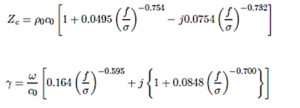
It forms the basis for other models today like Miki’s model from 1990 (that is developed from Delany and Bazley’s model) – but is a bit more accurate on the lower frequencies. Using these models we get an absorption coefficient that reflects reality and does NOT reflect a testing method in a lab. It is worth mentioning that large differences in AFR (by number) don’t always give big differences in the end. (fig. 4).
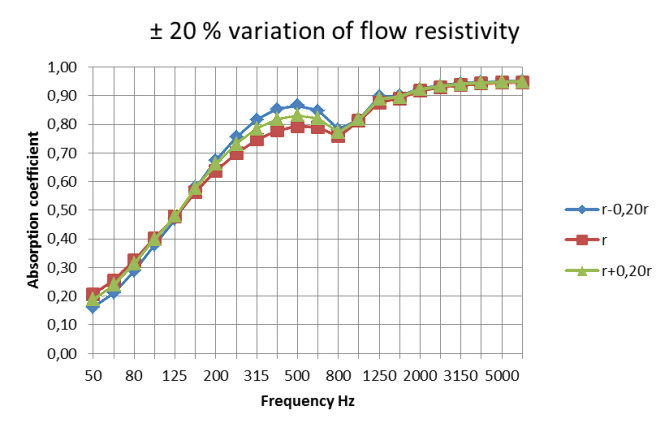
In short – when we know the AFR of a porous absorber we will have the possibility to calculate more accurate absorption coefficients (α) – and then we can calculate not only RT but also other acoustic descriptors like C50 and G.
Calculations based on AFR will often show ‘worse’ results (for RT, C50 and G) than what we can calculate using the Sabine equation and αp – but the results will be more accurate when we compare it to what actually happens in reality – shown in many many measurements. A new acoustic calculator is recently published by Ecophon – based on AFR and calculating RT, C50 and Gain. You can try the tool here.
We must never forget that the Sabine equation in itself is based on a condition that is difficult to obtain in reality. On top of this αp according to ISO 354 is to be seen as a PRODUCT parameter which is influenced by the measurement procedure – and not directly an applicable design parameter.
AFR should never be an argument in itself in regards to what products perform ‘best’. AFR is a product property that helps us to calculate more accurate acoustic descriptors relevant for educational, office and healthcare facilities.

